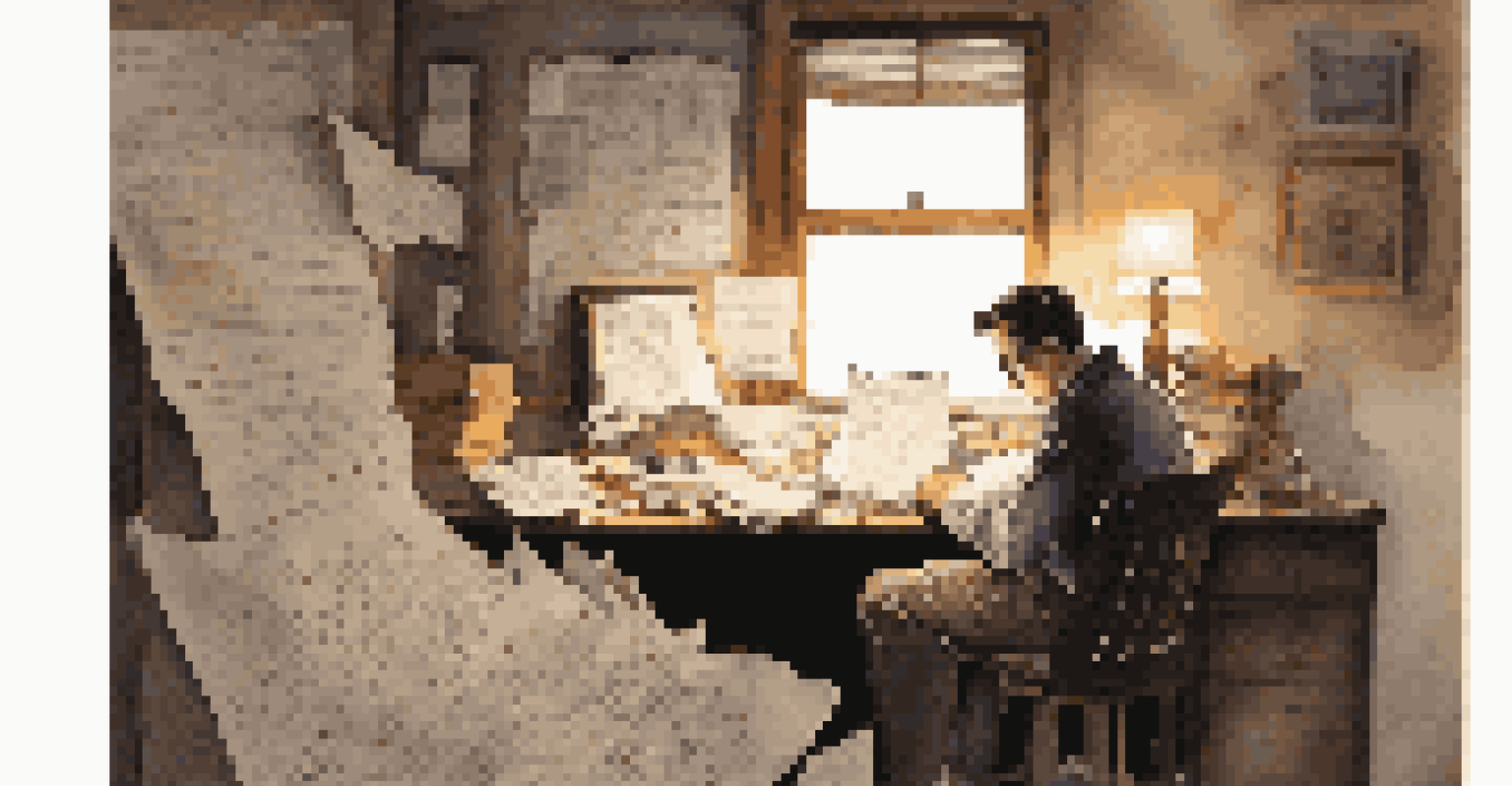Exploring the Art of Flash Fiction Writing

Understanding Flash Fiction: A Brief Introduction
Flash fiction is a unique storytelling form that captures a complete narrative in just a few hundred words. Unlike traditional short stories, flash fiction focuses on brevity while still delivering a powerful punch. This genre challenges writers to convey emotion and depth in a limited space, making it both an exciting and daunting task.
Brevity is the soul of wit.
Many writers are drawn to flash fiction for its ability to spark creativity. It allows for experimentation with characters, settings, and themes without the extensive commitment of a novel. In just a few sentences, you can explore complex emotions or create intriguing plot twists that leave readers wanting more.
For both seasoned authors and newcomers alike, flash fiction opens the door to endless possibilities. It encourages writers to think outside the box and refine their skills, all while engaging readers in a delightful and concise manner.
The Essential Elements of Flash Fiction
Despite its brevity, flash fiction still requires essential elements, including character, setting, conflict, and resolution. Each of these components must be present, albeit in a more condensed format. This challenge pushes writers to be efficient with their words and ensures every sentence serves a purpose.

A well-developed character can often be introduced in just a few lines, allowing readers to connect quickly. Similarly, the setting can be established through vivid imagery that transports the reader instantly. The key is to evoke feelings and paint a picture without overwhelming details.
Brevity is Key in Flash Fiction
Flash fiction distills a complete narrative into a few hundred words while delivering emotional depth and a compelling story.
Conflict is the heart of any good story, and in flash fiction, it must emerge swiftly and compellingly. Whether it's internal conflict or an external struggle, presenting this challenge succinctly is crucial for an effective story arc.
Crafting Compelling Characters in Limited Space
Creating relatable characters is fundamental to engaging flash fiction. Writers often have to rely on strong traits and defining moments to make characters memorable. A well-placed detail can reveal a character's personality instantly, allowing readers to form a connection quickly.
The most valuable thing you can make is a mistake – you can’t learn anything from being perfect.
Using dialogue effectively can also help bring characters to life in flash fiction. A few sharp lines can convey a lot about relationships and motivations without lengthy exposition. The goal is to create a vivid image of who the character is and what they desire.
Additionally, consider the character's journey within the constraints of your narrative. Even in a few hundred words, a character can undergo a transformation or realization that resonates deeply with the reader.
Setting the Scene: Importance of Context
In flash fiction, setting acts as a backdrop that enhances the story. A well-defined setting can evoke emotions and inform the reader about the characters’ circumstances. Think of it as a stage where the action unfolds, and every detail contributes to the overall mood.
Writers can use sensory details to immerse readers in the environment quickly. Describing sights, sounds, and smells can transport readers into the world you’ve created, making them feel part of the narrative. This technique is particularly powerful in flash fiction, where every word counts.
Characters Must Be Relatable
Creating memorable characters in flash fiction relies on strong traits and impactful moments that allow readers to connect quickly.
Moreover, the setting can also influence the plot and character dynamics. A rainy day can set a somber tone, while a bustling city can create a sense of urgency. Choosing the right backdrop is crucial to enhancing your story’s impact.
Building Conflict and Tension Effectively
Conflict drives the narrative forward, and in flash fiction, it needs to be introduced swiftly. Writers must create tension that captures the reader's attention from the first sentence. This can be accomplished through a dramatic event, a dilemma, or an unexpected twist that propels the story onward.
To maintain engagement, it's essential to escalate tension quickly, leading to a climax that feels satisfying despite the brevity. The challenge is to keep the reader invested in the characters’ struggles and desires, ensuring they care about the outcome.
In flash fiction, the resolution should also be concise yet impactful. Even a small moment of clarity or change can leave a lasting impression, prompting readers to reflect on the narrative long after they’ve finished reading.
The Art of Conciseness: Choosing Your Words Wisely
One of the most critical skills in flash fiction is the art of conciseness. Every word must serve a purpose, whether it adds to character development, sets the scene, or builds tension. Writers should strive to eliminate unnecessary fluff and focus on clarity and impact.
Consider using strong verbs and precise descriptions to convey meaning quickly. Instead of lengthy explanations, a single, vivid image can evoke a wealth of emotions and ideas. This approach not only enhances readability but also keeps the narrative moving at a brisk pace.
Conflict Drives the Narrative
In flash fiction, conflict must be introduced swiftly and escalate quickly to maintain reader engagement and lead to a satisfying resolution.
Moreover, don't shy away from leaving some things unsaid. Flash fiction often thrives on ambiguity, allowing readers to fill in the gaps with their interpretations. This can create a powerful connection, as readers engage actively with the story.
The Revision Process: Polishing Your Flash Fiction
Revision is a crucial step in crafting effective flash fiction. After writing your initial draft, take a step back and revisit it with fresh eyes. This process helps identify areas where the story could be tightened or enhanced, ensuring clarity and impact.
During revision, look for opportunities to trim excess words or phrases that dilute the narrative. Consider whether each sentence adds value to the story and contributes to character development or plot progression. The goal is to create a seamless flow that captivates readers.

Additionally, seeking feedback from others can provide valuable insights. Sharing your work with fellow writers or trusted readers can help identify strengths and weaknesses, guiding you toward a polished final piece that resonates with your audience.